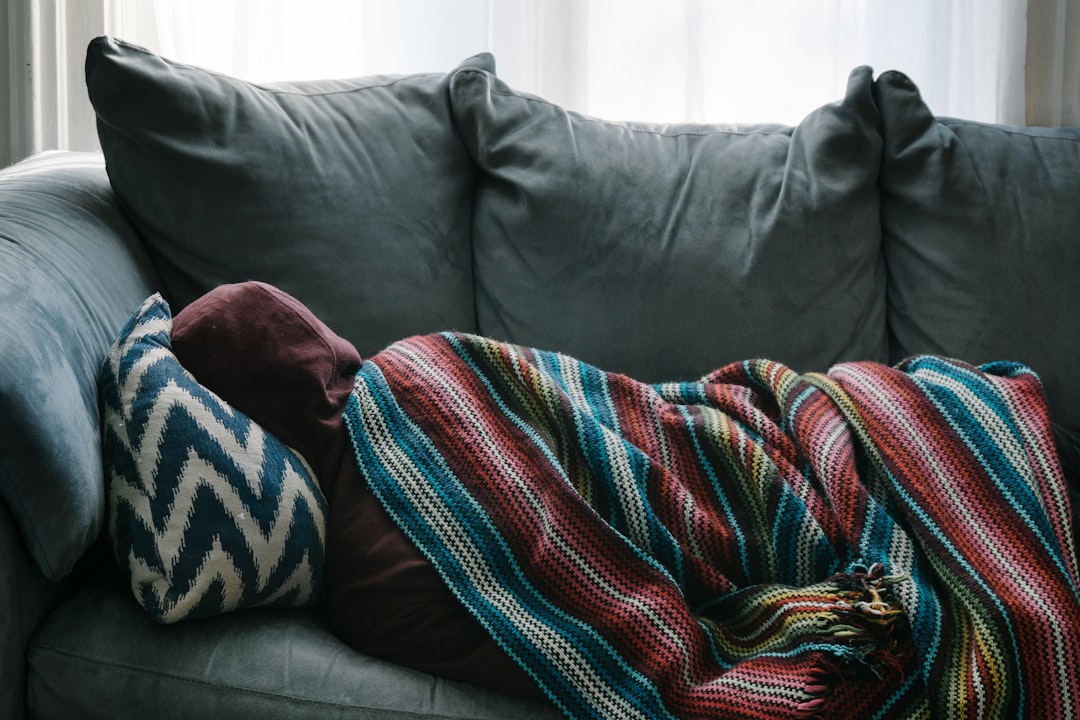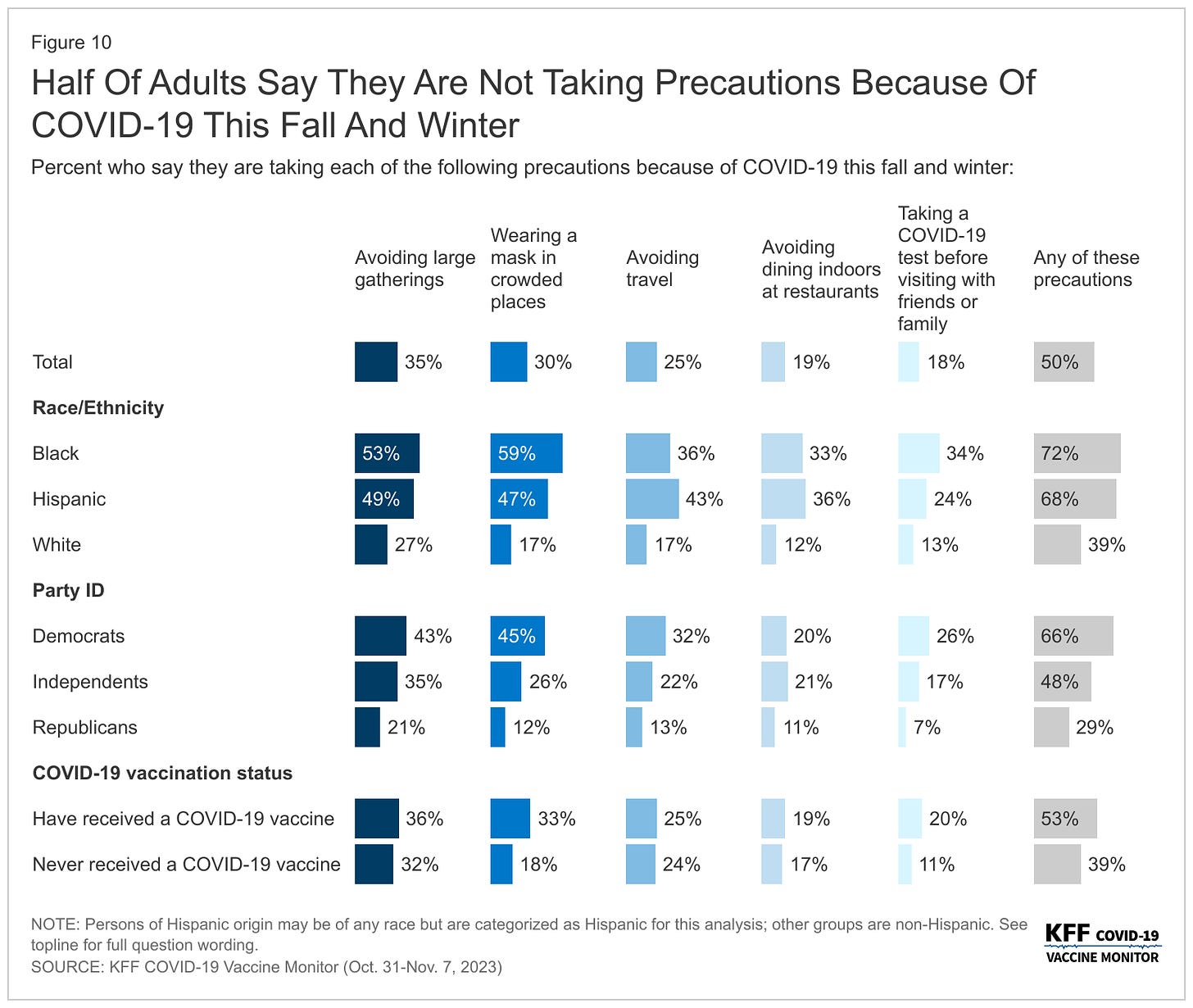Starting today, you can order another 4 free at-home COVID tests to be delivered to your house. If you did not yet order tests this fall, you may place two orders for a total of 8 tests. Go here to place your order.
It’s the holiday season! My favorite time of year.
We are also in “epidemic” mode for our fall and winter respiratory season. We can take small steps in the “background” to minimize sickness and maximize family time. That is, if you want to maximize time with your family. ;)
Here is an update on the latest on flu, RSV, and Covid-19.

But first… is anyone taking precautions anymore?
Yes.
I was surprised by a KFF report last week: 1 in 2 Americans still take precautions for the holiday season. Some groups do more than others, but there is a little bit of everything from everyone.
Prevent getting sick leading up to the event
Getting sick and missing holiday parties is a huge bummer. There are a few things we can do to prevent this:
Immunity, like vaccination, helps prevent infection for flu and Covid-19.
We don’t have evidence on RSV vaccines yet, but we think it does too.
Immunity against infection doesn’t last long and is certainly imperfect. (For how long and how much it prevents infection is really hard to quantify given the mix of studies and complex population immunity.)
Vaccination or infection takes about 2 weeks to boost the immune system.
Masks work on an individual level, especially if well-fit and filtered (like an N95).
We have evidence for flu and Covid-19. (Again, we don’t know with RSV, but we hypothesize this is the case.)
Mask in public 4-5 days before the event to reduce your chances of getting sick.
Ventilation and filtration is one of the most powerful tools because it works passively and invisibly to prevent illnesses. However, it relies on institutional action.
Planes, for example, are fantastic for ventilation, but only once the wheels are up. Getting to the plane (security, boarding area, etc.) is another story.
For what it’s worth, I’m doing these, including wearing a mask at the airports.
Reduce spreading viruses at the event

It’s almost impossible to know if you’re asymptomatic and/or contagious for any virus. This is a big bummer, especially for our high-risk family members also in attendance.
At-home tests
There is one flu/Covid-19 test. The rest are for Covid-19 only. There are none for RSV.
Covid-19 at-home tests are expensive and false negatives at the beginning of infection are very common, especially if you’re asymptomatic.
Cadence testing can help increase confidence in results, like two tests within 48 hours before the event:
Asymptomatic: Two tests 48 hours apart will catch 39% of asymptomatic cases
Symptomatic: 92% of cases will be caught
Do antigen tests expire? Expiration ranges from 6 months to 2 years, depending on the brand. The date on the box may be incorrect, as the FDA later extended dates. Here is an updated list to see if it’s still good after brushing off cobwebs.
Ventilation and filtration. If you’re hosting, get that air moving. Open windows. Buy an air filter. Set up your table outside, if the weather is friendly. Buy a CO2 monitor.
Does vaccination status matter? A recent study showed that vaccinated kids were as contagious as unvaccinated. This isn't surprising because almost everyone has some sort of immunity (vaccine, infection, hybrid).
What am I doing? We always have Thanksgiving outside in California. I’m not doing asymptomatic testing anymore with my family, given the expense and low catch rate.
Treatment: What to do if you’re sick?

If you have symptoms and/or a positive test, assume you’re contagious. Do not go to the event. The duration of infectiousness depends on the virus:
Flu: 5-7 days after symptoms start.
RSV: 3-8 days after. Some infants and people with weakened immune systems can spread the virus even after they stop showing symptoms, for as long as 4 weeks.
Covid-19: We see strong evidence (here, here) that an Omicron infection lasts, on average, 6-10 days. Children seem to be less infectious for less time.
Antigen tests. Positives are positives. You’re infectious. Stay in isolation for at least 5 days or until this line disappears. The faintness of a testing line can provide clues:
Very bold line = you’re very contagious.
Barely see the line = you’re at the beginning or the end of your infection window. It may be worth testing again in 24 hours to figure out which one.
Paxlovid. My first question to those over 65 with Covid-19 is: Did you get Paxlovid? It can help a lot.
Rebounding is common (i.e., turning positive once you were negative after taking Paxlovid). Rebounding can also happen without Paxlovid. Which is more common? We can’t tell from the current evidence.
Paxlovid is being privatized (i.e., no longer covered by government). Pfizer also announced an astronomical price: $1,400. Cost is a legitimate reason not to get it, which is devastating and ridiculous.
Does Paxlovid prevent long covid? There is mixed evidence at this time.
Bottom line
We can be smarter and healthier during the fall and winter. Small steps will maximize the probability of being healthy, staying healthy, reducing disruption, and enjoying the holiday season. To me, this is worth it.
Have a wonderful Thanksgiving!
Love, YLE
“Your Local Epidemiologist (YLE)” is written by Dr. Katelyn Jetelina, MPH Ph.D.—an epidemiologist, wife, and mom of two little girls. During the day, she is a senior scientific consultant to several organizations. At night she writes this newsletter. Her main goal is to “translate” the ever-evolving public health world so that people will be well-equipped to make evidence-based decisions. This newsletter is free, thanks to the generous support of fellow YLE community members. To support this effort, subscribe below:





Nice to see uncertainties clearly expressed. Happy Holidays and safe times to you all.
Thanks so much for this concise & informative update. Wishing your family a Happy Thanksgiving!